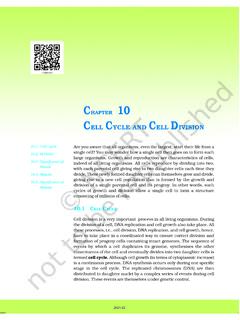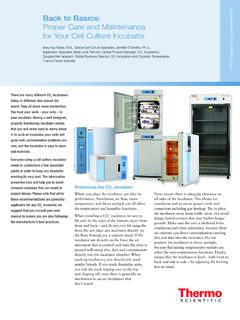Transcription of Lecture - Fertilization - Embryology
1 24/7/18, 7)55 amLecture - Fertilization - EmbryologyPage 1 of 24 [Expand][Expand]Historic drawing of human oocyte andspermatozoaLecture - FertilizationIntroductionThis Lecture will cover male andfemale gametogenesis development 1 embryonic cell(zygote) will produce about 1013(100,000,000,000,000) cells in theadult at any one time (over timewith cell death and ongoingreplacement this is substantiallymore).This is where the first embryonic cell begins! Fertilization is the fusion ofhaploid gametes, egg (oocyte) and sperm (spermatozoa), to form thediploid zygote. Note though there can be subtle differences in thefertilization process which occurs naturally within the body or throughreproductive technologies outside the body, the overall product in bothcases is a diplod - Print PDFAlso use the previous Lecture recording (below) to help understand thisonline Lecture Video Recording Some Recent Research Lecture Archive: 2016 Video | 2016 PDF | 2015 | 2015 PDF | 2014 PDF |2013 | 2012 | 2011 | 2010 | 200924/7/18, 7)55 amLecture - Fertilization - EmbryologyPage 2 of 24 [Expand][Expand] Lecture Objectives1.
2 Broad understanding of reproductive Understand the key features of Understand the differences in male and female Brief understanding of the differences between mitosis and Understanding of the events in - spermatogenesisLecture ResourcesMovies References Human Reproductive CycleSexual reproduction in most species is regulated by regular endocrinechanges, or cycles, in the female. These cycles begin postnatally, functionfor variable times and can then decrease or cease reproduction is regulated in females by the menstrualcycle, a regular cyclic hormonal change which coordinate changes inthe ovary and internal reproductive tract. This cycle commences atpuberty and ends at (rats, mice, horses, pig) reproduction is regulated infemales by the estrous cycle (British spelling, oestrous).
3 FemaleMaleMenstrual cycle a regular cycle ofreproduction (28 days)begins at puberty, release of 1 egg(oocyte) every cyclecontinuous production of sperm(spermatozoa)begins at puberty, release millionsof spermatozoa24/7/18, 7)55 amLecture - Fertilization - EmbryologyPage 3 of 24 controlled (HPG axis)Hypothalamus - Pituitary -GonadEndocrine controlled (HPG axis)Hypothalamus - Pituitary -Gonad24/7/18, 7)55 amLecture - Fertilization - EmbryologyPage 4 of 24 in the gonad (ovary or testis) produces the haploid gametes, oocyteand spermatozoa (egg and sperm). Meiosis time course and final gametenumber differs between female and - SpermatogenesisHuman spermatozoa (electron microscope)24/7/18, 7)55 amLecture - Fertilization - EmbryologyPage 5 of 24 spermatozoa (electron microscope)The testes have two produce the male gametes or spermatozoa2.
4 Produce male sexual hormone, testosterone (internal and externalgenitalia, sex characteristics)Historic testis drawingChild Seminiferous tubuleAdult Seminiferous tubuleSeminiferous tubule cross-section and supporting cellsHuman spermatozoa take about 48 days from entering meiosis untilmorphologically mature - are the diploid first cells of24/7/18, 7)55 amLecture - Fertilization - EmbryologyPage 6 of 24 spermatocytes - large, enter theprophase of the first meiotic divisionSecondary spermatocytes - small, completethe second meiotic divisionSpermatid - immature spermatozoaSpermatozoa - differentiated gameteSpermatozoa development:primordial germ cell - spermatogonia -primary spermatocyte - secondaryspermatocytes - spermatid - spermatozoaSertoli cells (support cells )Interstitial cells or Leydig cells (producehormone)Female - OogenesisThe ovaries have two produce the female gametes or oocytes2.
5 Produce female hormones, estrogen and progesterone (secondary sexcharacteristics, menstrual cycle )three stages of follicle developmentIn an adult human female the development of a primordial folliclecontaining an oocyte to a preovulatory follicle takes in excess of 120 , 7)55 amLecture - Fertilization - EmbryologyPage 7 of 24 [Expand][Expand]Human Follicle DevelopmentHuman OvulationHuman ovary follicle developmentOvarian Follicle Stages: primordial follicle - primary follicle -secondary follicle - tertiary follicle - preovulatory follicleFollicle cells (support cells ) Theca cells (produce hormone)Ovulation Movie Meiosis DifferencesTypes of Cell Division Male MeiosisMeiosis initiated continuously in a mitoticallydividing stem cell population4 gametes produced / meiosisMeiosis completed in days or weeksMeiosis and differentiation proceed continuouslywithout cell cycle arrestDifferentiation of gamete occurs while haploid aftermeiosis endsSex chromosomes excluded from recombinationand transcription during first meiotic prophaseMale gametogenesis24/7/18, 7)
6 55 amLecture - Fertilization - EmbryologyPage 8 of 24 [Expand]MBoC - Figure 20-27. The stages of spermatogenesisFemale MeiosisMeiosis initiated once in a finite population of cells1 gamete produced / meiosisCompletion of meiosis delayed for months or yearsMeiosis arrested at 1st meiotic prophase andreinitiated in a smaller population of cellsDifferentiation of gamete occurs while diploid infirst meiotic prophaseAll chromosomes exhibit equivalent transcriptionand recombination during meiotic prophaseThe Cell - Figure Meiosis of vertebrate oocytesFemalegametogenesisPolar BodiesIn female gametogenesis only a single (1) haploid egg isproduced from meiosis. In male gametogenesis four (4)haploid sperm are produced from meiosis.
7 So what happens toall the extra DNA in producing this single egg?Meiosis 1 the "extra" DNA is excluded to the periphery asa 1st polar body, which encloses the extra 2 the "extra" DNA is once again excluded as a2nd polar body. The first polar body may also under gomeiosis 2 producing a 3rd polar polar bodies are not bodies have no other function other than to disposeof the extra DNA in recent research in mice suggest that oocyte polarbody position may influence Fertilization Polar Body Movie FertilizationGamete formation, menstrual cycle and fertilisation will also be covered indetail in this week's Laboratory. Fertilization is the complete processresulting in the fusion of haploid gametes, egg and sperm, to form the24/7/18, 7)55 amLecture - Fertilization - EmbryologyPage 9 of 24 [Expand]Human uterine tube ciliated epitheliumdiploid zygote.
8 The recent development of aided Fertilization is describedas in vitro Fertilization (in vitro = "in glass", outside the body, IVF).Clinically, all these aided Fertilization techniques are grouped as AssistedReproductive Technologies or - 1 gamete produced/meiosis + 3 polar bodies, meiosis isslow, 1 egg produced and released at ovulationSpermatogenesis - 4 gametes produced/meiosis, meiosis is fast, 200-600 million sperm released at ejaculationFertilization Movies Fertilization SiteFertilization resulting inembryo development usuallyoccurs in first 1/3 of uterinetube (oviduct, Fallopian tube)The majority of fertilizedoocytes do not go on to form anembryoFertilization can also occuroutside uterine tube associatedwith Assisted ReproductiveTechnology (IVF, GIFT, )
9 And ectopic pregnancyOocyte ovulation - release from the ovary with associated cells , intoperitoneal cavity, uterine tube fimbria then into uterine tube (oviduct,uterine horn, fallopian tube) and epithelial cilia mediated ejaculation - deposited in vagina, movement of tail to"swim" in uterine secretions through cervix, uterine body and intouterine tube, have approximately 24-48h to fertilize to the Fertilization process commencing both the gametes complete of24/7/18, 7)55 amLecture - Fertilization - EmbryologyPage 10 of 24 [Expand]Human spermatozoa (light microscope)a number of biological Meiosis - completes Meiosis 1 and commences Meiosis 2(arrests at Metaphase II).Spermatozoa Capacitation - following release (ejaculation) andmixing with other glandular secretions, activates motility andacrosome - both oocyte and - Diagram of the comparative anatomy of the male andfemale reproductive tractsGamete Movement Movies Fertilization - MaleSpermatozoa.
10 Ejaculation -Capacitation - Spermatozoa motility- Chemotaxis - Binding to zonapellucida - Acrosome reaction -Membrane fusionEjaculationabout ml, containing 200 -600 million spermatozoaby volume less than 10 %spermatozoaaccessory glands contributemajority of volume (60 % seminal vesicle, 10 % bulbourethral, 30 %prostate)Male InfertilityOligospermia (Low Sperm Count) - less than 20 million sperm after24/7/18, 7)55 amLecture - Fertilization - EmbryologyPage 11 of 24 hour abstinence from sexAzoospermia (Absent Sperm) - blockage of duct networkImmotile Cilia Syndrome - lack of sperm motilityCapacitationspermatozoa activation process - removal of glycoprotein coat andseminal proteins and alteration of sperm mitochondriaSpermatozoa motilitytail of spermatozoa provide movement by microtubulesenergy for this movement is provided by mitochondria in tail initialsegmentChemotaxisoocyte cumulus cells release progesterone (may also be other oocyteand follicular fluid factors)Spermatozoa BindingZona pellucida protein ZP2 acts as receptor for spermatozoa binding(species specific)24/7/18, 7)

